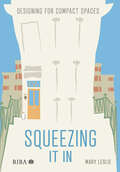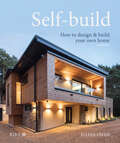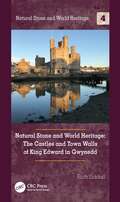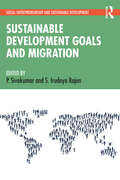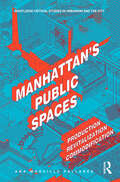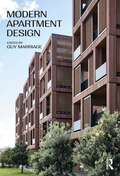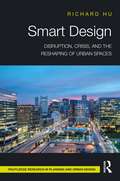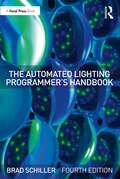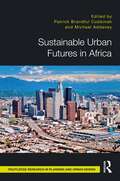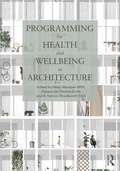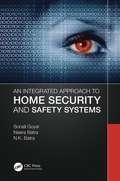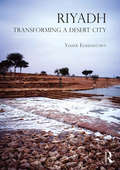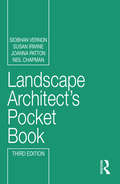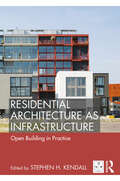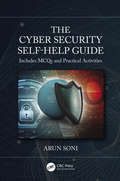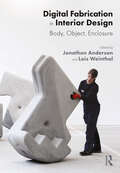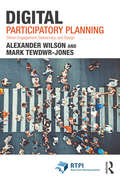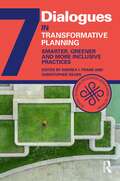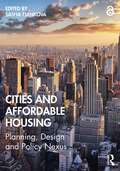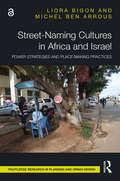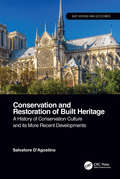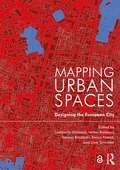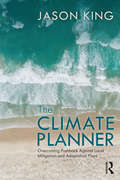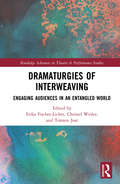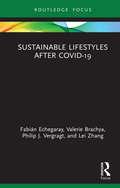- Table View
- List View
Squeezing It In: Designing for compact spaces
by Mary LeslieOur living spaces are getting smaller but, as we spend more time at home, they must now work harder than ever to provide us with room to relax, work and entertain. Interior designers need to understand how to build accessibility, circulation, storage and lighting into the most restricted areas, without compromising on style. In this jargon-free guide, Mary Leslie demonstrates how to design for compact living, proposing creative solutions that can be applied to a variety of settings. A versatile designer may be addressing a cramped studio flat one day and a dressing room for an international business traveller the next; this book provides inspiration and advice for every kind of small space, and every budget. Organised around the different areas of the home, Squeezing It In examines familiar problems and offers clever, immediately applicable ideas for making the best of pocket-sized spaces. The entire design process is considered alongside complete examples, from the UK and internationally, which are generously illustrated with full-colour photographs, plans and sketches. Featuring case studies from: Archio Ltd Armstrong Keyworth Benjamin Tindall Architects Darren Oldfield Architects Jeffreys Interiors Papa Architects Peden & Pringle Plankbridge Ltd.
Self-build: How to design and build your own home
by Julian OwenIf you’ve ever dreamt of designing and building your own home, this book is for you. Becoming a ‘self-builder’ doesn’t necessarily mean learning to build a house physically from scratch. Anyone can be a self-builder – you can do so without ever having to lay a brick yourself. Self-built homes can also be more individual, better designed and more economical than buying from a developer. This book is designed for homeowners and self-builders, whether aspiring or on the brink of starting a project. It provides a jargon-free, step-by-step guide to the process of designing and building your own home, distilling all of the practical information needed to make your dream house a reality. Carefully crafted to offer friendly, easy-to-understand practical guidance and packed with watch points, hints and tips, it also highlights the potential pitfalls and suggests ways of avoiding them. Including indications of costs and timescales, Self-build demystifies the process of budgeting, finding a site, gaining planning permission, designing your home and all of the surrounding issues to do with sustainability, planning, regulations, procurement and the use of building contracts. Beautifully illustrated with over 230-colour photos, diagrams and plans, it provides all the inspiration and ideas you need to bring your own project to life. Featured houses include: Amphibious House by Baca Architects Corten Courtyard House by Barefoot Architects Haringey Brick House by Satish Jassal Architects Shawm House by Mawson Kerr Architects Sussex House by Wilkinson King Architects The Pocket House by Tikari Works Architects.
Natural Stone and World Heritage: The Castles and Town Walls of King Edward in Gwynedd (Natural Stone and World Heritage)
by Ruth SiddallThis book is about the stone used to build the castles of Edward I in North West Wales. It provides a description of the available geological resources and the building materials used in the construction of Caernarfon, Conwy, Harlech and Beaumaris Castles. It takes a broad view of this subject, placing the stone used in the castles in the context of both earlier and later buildings across the region of study, from the Neolithic up until the present day. The book will serve as a useful source book for geologists, archaeologists, architects, representatives of the natural stone industry, historians and cultural heritage management professionals specifically and for academic and non-academic communities, travellers and tourism industry operators in general.
Sustainable Development Goals and Migration (Towards Sustainable Futures)
by P. Sivakumar S. Irudaya RajanThis book looks at migration in contemporary society and its interrelations with development. It presents the complexities and dilemmas associated with migration, the changes in theoretical and historical perspectives on migration and development, and the role of policies and the sustainable development goals in this context. The volume views migration as a phenomenon for advancing human development outcomes. It deals with wide-ranging issues including labour migration, the idea of decent work, migration and transnationalism, remittances, social networks and capital, and addressing poverty. The chapters highlight the focus of the Sustainable Development Goals (SDGs) and its relevance on migrant rights, safeguarding livelihoods and health. They also offer insights into regional and international co-operation on policies for migration, social growth and protection, and citizenship. With comparative analyses of data, trends and development indicators as well as various case studies, this volume examines the impact of migration on international relations and politics, labour market outcomes, gender, youth and education among others. It also discusses the loss of lives and livelihoods due to the Covid-19 pandemic, its impact on migration and the effects of the pandemic on the contemporary discussions on migration and SDGs. Rich in empirical data, this book will be an excellent read for scholars and researchers of migration and diaspora studies, development studies, refugee studies, public policy and governance, international relations, political studies, political economy, sociology and South Asian Studies.
Manhattan's Public Spaces: Production, Revitalization, Commodification (Routledge Critical Studies in Urbanism and the City)
by Ana Morcillo PallarésManhattan’s Public Spaces: Production, Revitalization, Commodification analyzes a series of architectural works and their contribution to New York’s public space over the past few decades. By exploring a mix of urban mechanisms, supportive frameworks, legal systems, and planning guidelines for the transformation of the city’s collective realm, the text frames Manhattan as a controversial landscape of interests and concerns to authorities, communities, and, very importantly, developers. The production, revitalization, and commodification of Manhattan’s public spaces, as a phenomenon and as a subject of study, also highlights the vicissitudes of the reconciliation of the many different agents, which are part of the process. The challenge of the book does not only lie in the analysis of good design but, more importantly, in how to understand the functional mechanisms for the current trends in the production of space for public use. A complex framework of actors, governance, and market monopolies, which invites the reader to participate in the debate of how these interventions contribute, or not, to an inclusive environment anchored in the existing built fabric. Manhattan’s Public Spaces invites reflection on the revitalization of the city’s shared space from all dimensions. Beautifully illustrated in black and white, with over 50 images, this book will be of interest to scholars and students in architecture, planning, and urban design.
Modern Apartment Design
by Guy MarriageModern Apartment Design provides guidelines to the design of modern apartment buildings as well as a summation of current cutting-edge practice in engineered timber construction. The book covers a brief history of apartment buildings around the world, with a broad outline of different types of apartment blocks. It has a strong focus on the design and actual construction of apartment buildings, especially those utilising mass timber, such as cross-laminated timber and laminated veneer lumber. It also features six Case Study chapters from industry-leading practitioners in the area, enabling best practice in architecture and engineering of these new apartment building types to be more widely understood and propagated worldwide. The fully illustrated, full-colour case studies span the globe and include: Clearwater Quay in Christchurch, New Zealand (Pacific Environments NZ); Wynyard Central East 2 in Auckland, New Zealand (Architectus); Dalton Works in London, UK (Waugh Thistleton Architects); Mjøstårnet, Brumunddal, Norway (Voll Arkitekter); Brock Commons Tallwood House student housing in Vancouver, Canada (Acton Ostry Architects); and Regensbergstrasse apartments in Zurich, Switzerland (Dreicon). The book will be of great interest to architects and architecture students.
Smart Design: Disruption, Crisis, and the Reshaping of Urban Spaces
by Richard HuThis book tackles the emerging smart urbanism to advance a new way of urban thinking and to explore a new design approach. It unravels several urban transformations in dualities: economic relationality and centrality, technological flattening and polarisation, and spatial division and fusion. These dualities are interdependent; concurrent, coexisting, and contradictory, they are jointly disrupting and reshaping many aspects of contemporary cities and spaces. The book draws on a suite of international studies, experiences, and observations, including case studies in Beijing, Singapore, and Boston, to reveal how these processes are impacting urban design, development, and policy approaches. The COVID-19 pandemic has accelerated many changes already in motion, and provides an extreme circumstance for reflecting on and imagining urban spaces. These analyses, thoughts, and visions inform an urban imaginary of smart design that incorporates change, flexibility, collaboration, and experimentation, which together forge a paradigm of urban thinking. This paradigm builds upon the modernist and postmodernist urban design traditions and extends them in new directions, responding to and anticipating a changing urban environment. The book proposes a smart design manifesto to stimulate thought, trigger debate, and, hopefully, influence a new generation of urban thinkers and smart designers. It will be of interest to scholars, students, and practitioners in the fields of urban design, planning, architecture, urban development, and urban studies.
The Automated Lighting Programmer's Handbook
by Brad SchillerThe Automated Lighting Programmer’s Handbook, fourth edition, provides respected and clear coverage of the process of programming automated lighting fixtures from basic principles to advanced production preparations. This guide helps lighting programmers and designers with the creative and operational challenges they face in their rapidly evolving industry. Concepts, procedures, and guidelines to ensure a successful production are covered as well as troubleshooting, much needed information on workflows, technology, work relationships, console networking, digital lighting, and more. Chapters are peppered with advice and war stories from some of the most prominent lighting designers and programmers of today. The fourth edition is the most comprehensive yet: added topics include programming structure, advanced recording/editing, cloning, multi-cell fixtures, safety routines, GDTF, and pre-visualization. Deep explorations into the work of programmers from Earlybird and Broadway provide readers with timely real-world scenarios and advice. The information in this book is perfect for anyone interested in the programming of automated lighting in any market. From the beginner to the expert, the methodologies within provide simple, yet powerful tools to assist with any production. Lighting designers also will gain important knowledge about the procedures and concepts utilized by lighting programmers.
Sustainable Urban Futures in Africa
by Patrick Brandful CobbinahSustainable Urban Futures in Africa provides a variety of conventional and emerging theoretical frameworks to inform understandings and responses to critical urban development issues such as urbanisation, climate change, housing/slum, informality, urban sprawl, urban ecosystem services and urban poverty, among others, within the context of the sustainable development goals (SDGs) in Africa. This book addresses topics including challenges to spatial urban development, how spatial planning is delivered, how different urbanisation variables influence the development of different forms of urban systems and settlements in Africa, how city authorities could use old and new methods of land administration to produce sustainable urban spaces in Africa, and the role of local activism is causing important changes in the built environment. Chapters are written by a diverse range of African scholars and practitioners in urban planning and policy design, environmental science and policy, sociology, agriculture, natural resources management, environmental law, and politics. Urban Africa has huge resource potential – both human and natural resources – that can stimulate sustainable development when effectively harnessed. Sustainable Urban Futures in Africa provides support for the SDGs in urban Africa and will be of interest to students and researchers, professionals and policymakers, and readers of urban studies, spatial planning, geography, governance, and other social sciences.
Programming for Health and Wellbeing in Architecture
by Keely Menezes MphProgramming for Health and Wellbeing in Architecture presents a new approach to architectural programming that includes sustainability, neuroscience and human factors. This volume of contributions from noted architects and academics makes the case for rethinking the practices of programming and planning to incorporate evidence-based design, systems thinking and a deeper understanding of our evolutionary nature. These 18 original essays highlight how human and environmental health are closely related and should be incorporated as mutually reinforcing goals in every design project. Together, these chapters describe the framework for a new paradigm of building performance and design of the human experience. Programming—the stage at which research is conducted and goals established—provides an opportunity to examine potential impacts and to craft strategies for wellbeing in new buildings and renovations using the latest scientific methods. This book expands the scope of the programming process and provides essential guidance for sustainable practice and the advancement of wellbeing in the built environment for architecture and interiors students, practitioners, instructors and academics.
An Integrated Approach to Home Security and Safety Systems
by Sonali Goyal Neera BatraThis book provides an integrated solution for security and safety in the home, covering both assistance in health monitoring and safety from strangers/intruders who want to enter the home with harmful intentions. It defines a system whereby recognition of a person/stranger at the door is done using three modules: Face Recognition, Voice Recognition and Similarity Index. These three modules are taken together to provide a percentage likelihood that the individual is in the "known" or "unknown" category. The system can also continuously monitor the health parameters of a vulnerable person living alone at home and aid them in calling for help in an emergency. The authors have analyzed a number of existing biometric techniques to provide security for an individual living alone at home. These biometric techniques have been tested using MATLAB® image processing and signal processing toolboxes, and results have been calculated on the basis of recognition rate. A major contribution in providing security is a hybrid algorithm proposed by the author named PICA, which combines features of both PCA (Principle Component Analysis) and ICA (Independent Component Analysis) algorithms. This hybrid approach gives better performance recognition than either system alone. The second proposed hybrid algorithm for voice recognition is named as a MFRASTA algorithm by combining features of MFCC (Mel Frequency Cepstral Coefficient) and RASTA-PLP (RelAtive SpecTrA-Perceptual Linear Prediction) algorithm. After performing experiments, results are collected on the basis of recognition rate. The authors have also proposed a third technique named as a Similarity Index to provide trust-based security for an individual. This technique is text independent in which a person is recognized by pronunciation, frequency, tone, pitch, etc., irrespective of the content spoken by the person. By combining these three techniques, a high recognition rate is provided to the person at the door and high security to the individual living independently at home. In the final contribution, the authors have proposed a fingertip-based application for health monitoring by using the concept of sensors. This application is developed using iPhone 6’s camera. When a person puts their fingertip on a camera lens, with the help of brightness of the skin, the person’s heartbeat will be monitored. This is possible even with a low-quality camera. In case of any emergency, text messages will be sent to the family members of the individual living alone by using 3G Dongle and MATLAB tool. Results show that the proposed work outperforms all the existing techniques used in face recognition, voice recognition, and health monitoring alone.
Riyadh: Transforming a Desert City (Planning, History and Environment Series)
by Yasser ElsheshtawyRiyadh has set its sights on becoming a world city befitting the twenty-first century. To that end it has embarked on a massive construction drive evidenced in the proliferation of proposals for high-end districts, giga-developments and elaborate infrastructures. An urban vision seemingly dedicated to attracting global capital. Yet such a narrative can be misleading. A ‘humanization programme’, initiated during the tenure of its former mayor Abdulaziz bin Ayyaf, has complemented the city’s rapid rise by providing spaces catering for the everyday needs of its inhabitants. Yasser Elsheshtawy, in this richly illustrated book, targets these people-centred settings. It is a compelling counter-narrative interweaving critical theoretical insights, personal observations, and serendipitous encounters. He deftly demonstrates how Riyadh thrives through the actions of its people. As the world moves towards an urban model that is resilient and humane, the humanizing efforts of an Arab city are worthy of our attention. Riyadh’s premise is perhaps best captured in the cover image depicting the desert riverbed of Wadi Sulai, filled with rainwater, making its way towards the Saudi capital. Along its banks there will be dedicated public pathways and urban parks. It is a vision of an urbanity where both the spectacular and the everyday coexist. A city that is not just dedicated to the few, but one that serves the many.
Landscape Architect's Pocket Book (Routledge Pocket Books)
by Siobhan Vernon Susan Irwine Joanna Patton Neil ChapmanThis third edition of the bestselling Landscape Architect’s Pocket Book, written by leading practitioners, incorporates updates and revisions to environmental and building regulations, contracts, and a range of design guidelines including materials, SuDS, environmental impact, and landscape character assessment. The book is an indispensable tool for all landscape architects, providing a timesaving guide and first point of reference to everyday topics, both out on site and in the office. The pocket book covers all major subjects, including hard and soft landscaping, national guidelines and standards, and key planning policy and legislation. Providing concise, easy-to-read reference material, useful calculations, and instant access to a wide range of topics, it is an essential resource for landscape architects, construction industry professionals, and students.
Residential Architecture as Infrastructure: Open Building in Practice (Open Building)
by Stephen H. KendallThis edited collection provides an up-to-date account, by a group of well-informed and globally positioned authors, of recently implemented projects, public policies and business activities in Open Building around the world. Countless residential Open Building projects have been built in a number of countries, some without knowledge of the original theory and methods. These projects differ in architectural style, building industry methods, economic system and social aims. National building standards and guidelines have been promulgated in several countries (Finland, China, Japan, Korea), providing incentives and guidance to Open Building implementation. Businesses in several countries have begun to deliver advanced FIT-OUT systems both for new construction and for retrofitting existing buildings, demonstrating the economic advantages of ‘the responsive, independent dwelling.’ This book also argues that the ‘open building’ approach is essential for the reactivation of the existing building stock for long-term value, because in the end it costs less. The book discusses these developments in residential architecture from the perspective of an infrastructure model of built environment. This model enables decision-makers to manage risk and uncertainty, while avoiding a number of problems often associated with large, fast-moving projects, such as separation and distribution of design tasks (and responsibility) and the ensuing boundary frictions. Residential Architecture as Infrastructure adds to the Routledge Open Building Series, and will appeal to architects, urban designers, researchers and policy-makers interested in this international review of current projects, policies and business activities focused on Open Building implementation.
The Cybersecurity Self-Help Guide
by Arun SoniCybercrime is increasing at an exponential rate. Every day, new hacking techniques and tools are being developed by threat actors to bypass security systems and access private data. Most people do not know how to secure themselves, their devices, and their media shared online. Especially now, cybercriminals appear to be ahead of cybersecurity experts across cyberspace. During the coronavirus pandemic, we witnessed the peak of cybercrime, which is likely to be sustained even after the pandemic. This book is an up-to-date self-help guide for everyone who connects to the Internet and uses technology. It is designed to spread awareness about cybersecurity by explaining techniques and methods that should be implemented practically by readers. Arun Soni is an international award-winning author who has written 159 books on information technology. He is also a Certified Ethical Hacker (CEH v8) from the EC-Council US. His achievements have been covered by major newspapers and portals, such as Business Standard, The Economic Times, Indian Express, The Tribune, Times of India, Yahoo News, and Rediff.com. He is the recipient of multiple international records for this incomparable feat. His vast international exposure in cybersecurity and writing make this book special. This book will be a tremendous help to everybody and will be considered a bible on cybersecurity.
Digital Fabrication in Interior Design: Body, Object, Enclosure
by Jonathon Anderson Lois WeinthalDigital Fabrication in Interior Design: Body, Object, Enclosure draws together emerging topics of making that span primary forms of craftsmanship to digital fabrication in order to theoretically and practically analyze the innovative and interdisciplinary relationship between digital fabrication technology and interior design. The history of making in interior design is aligned with traditional crafts, but a parallel discourse with digital fabrication has yet to be made evident. This book repositions the praxis of experimental prototyping and integrated technology to show how the use of digital fabrication is inherent to the interior scales of body, objects and enclosure. These three scales act as a central theme to frame contributions that reinforce the interdisciplinary nature of interior design and reinterpret traditional crafts by integrating new methods of making into conventional workflows. Featuring significant international practitioners and researchers, the selected contributions represent the ever-increasing interdisciplinary nature of design, demonstrating a breadth of disciplines. A foundational text for interiors students and practitioners, Digital Fabrication in Interior Design expands the necessary dialogue about digital fabrication at the scale of interiors to inform design theory and practice.
Digital Participatory Planning: Citizen Engagement, Democracy, and Design (RTPI Library Series)
by Alexander Wilson Mark Tewdwr-JonesDigital Participatory Planning outlines developments in the field of digital planning and designs and trials a range of technologies, from the use of apps and digital gaming through to social media, to examine how accessible and effective these new methods are. It critically discusses urban planning, democracy, and computing technology literature, and sets out case studies on design and deployment. It assesses whether digital technology offers an opportunity for the public to engage with urban change, to enhance public understanding and the quality of citizen participation, and to improve the proactive possibilities of urban planning more generally. The authors present an exciting alternative story of citizen engagement in urban planning through the reimagination of participation that will be of interest to students, researchers, and professionals engaged with a digital future for people and planning.
Transformative Planning: Smarter, Greener and More Inclusive Practices
by Andrea I. FrankThe Dialogues in Urban and Regional Planning series offers a selection of some of the best scholarship in urban and regional planning from around the world with internationally recognized authors taking up urgent and salient issues from theory, to education for and practice of planning. This 7th volume features contributions on the theme of Transformative Planning: Smarter, Greener and More Inclusive Practices. It includes chapters from leading planning scholars and practitioners who critically examine how transformative planning practices seek to reduce inequalities, promote sustained, inclusive and sustainable economic growth, achieve gender equality, improve human health and well-being, foster resilience of urban communities and protect the environment and thereby change urban planning paradigms. Several case studies of emerging transformative planning interventions illustrate practical ways forward. Transformative Planning offers provocative insights into the global planning community’s struggle and contribution to tackle the major challenges to society in the 21st century. It will be of use for advanced undergraduate and graduate courses in the wide-ranging fields encompassed by urban studies, sustainability studies, and urban and regional planning. The Dialogues in Urban and Regional Planning (DURP) series is published in association with the Global Planning Education Association Network (GPEAN) and its member national and transnational planning schools associations.
Cities and Affordable Housing: Planning, Design and Policy Nexus
by Sasha TsenkovaThis book provides a comparative perspective on housing and planning policies affecting the future of cities, focusing on people- and place-based outcomes using the nexus of planning, design and policy. A rich mosaic of case studies features good practices of city-led strategies for affordable housing provision, as well as individual projects capitalising on partnerships to build mixed-income housing and revitalise neighbourhoods. Twenty chapters provide unique perspectives on diversity of approaches in eight countries and 12 cities in Europe, Canada and the USA. Combining academic rigour with knowledge from critical practice, the book uses robust empirical analysis and evidence-based case study research to illustrate the potential of affordable housing partnerships for mixed-income, socially inclusive neighbourhoods as a model to rebuild cities. Cities and Affordable Housing is an essential interdisciplinary collection on planning and design that will be of great interest to scholars, urban professionals, architects, planners and policy-makers interested in housing, urban planning and city building.
Street-Naming Cultures in Africa and Israel: Power Strategies and Place-Making Practices
by Liora Bigon Michel Ben ArrousThis book is focused on the street-naming politics, policies and practices that have been shaping and reshaping the semantic, textual and visual environments of urban Africa and Israel. Its chapters expand on prominent issues, such as the importance of extra-formal processes, naming reception and unofficial toponymies, naming decolonisation, place attachment, place-making and the materiality of street signage. By this, the book directly contributes to the mainstreaming of Africa’s toponymic cultures in recent critical place-names studies. Unconventionally and experimentally, comparative glimpses are made throughout between toponymic experiences of African and Israeli cities, exploring pioneering issues in the overwhelmingly Eurocentric research tradition. The latter tends to be concentrated on Europe and North America, to focus on nationalistic ideologies and regime change and to over-rely on top-down ‘mere’ mapping and street indexing. This volume is also unique in incorporating a rich and stimulating variety of visual evidence from a wide range of African and Israeli cities. The materiality of street signage signifies the profound and powerful connections between structured politics, current mundane practices, historical traditions and subaltern cultures. Street-Naming Cultures in Africa and Israel is an important contribution to urban studies, toponymic research and African studies for scholars and students. Chapters 1 and 2 of this book are freely available as a downloadable Open Access PDF under a Creative Commons Attribution-Non Commercial-No Derivatives 4.0 license available at http://www.taylorfrancis.com/books/e/9781003173762
Conservation and Restoration of Built Heritage: A History of Conservation Culture and its More Recent Developments (Built Heritage and Geotechnics)
by Salvatore D'AgostinoThe word conservation, when used in the context of the preservation of built heritage, implies an intrinsically complex concept that evolved over time, since it has been influenced by the perception of history throughout time. This volume emphasises why an understanding of the cultural evolution of the conservation approach must be considered a prerequisite for architects and engineers if they are to cooperate in full harmony with historic-artistic culture for the preservation of global built heritage. In particular, the volume highlights how, during the second half of the last century, the preservation process also involved engineering – the science of making practical applications of knowledge – which, for a long time, made an uncritical use of techniques and materials and devised interventions on historical heritage that were heavily invasive. The volume also devotes special attention to the problems related to seismic risk, to which Italy, Greece and Portugal are particularly prone. Problems that emerge during the crisis and reconstruction phases are dealt with in detail, as is scheduled maintenance, as this latter approach always constitutes an improvement in the performance of the monument and is the most appropriate tool for the conservation of the built heritage. Finally, the volume collects examples of building restoration with case studies of many outstanding monuments. The work will appeal to professionals and academics in the broader fields of civil engineering (both geotechnical and structural engineering), architecture, art history, the history of architecture, restoration and cultural heritage management. This book will: Provide a critical reading of the history of conservation; Discuss materials and techniques of ancient architecture; Cover seismic vulnerability and preservation of the historic integrity of the monument; Advocate an approach based on programmed maintenance; Feature numerous case histories, including St Mark’s Basilica in Venice and the complex restoration of the cathedral of Notre-Dame in Paris.
Mapping Urban Spaces: Designing the European City
by Lamberto Amistadi Valter Balducci Tomasz Bradecki Enrico Prandi Uwe SchröderMapping Urban Spaces focuses on medium-sized European cities and more specifically on their open spaces from psychological, sociological, and aesthetic points of view. The chapters illustrate how the characteristics that make life in medium-sized European cities pleasant and sustainable – accessibility, ease of travel, urban sustainability, social inclusiveness – can be traced back to the nature of that space. The chapters develop from a phenomenological study of space to contributions on places and landscapes in the city. Centralities and their meaning are studied, as well as the social space and its complexity. The contributions focus on history and theory as well as concrete research and mapping approaches and the resulting design applications. The case studies come from countries around Europe including Poland, Italy, Greece, Germany, and France, among others. The book will be of interest to students, scholars, and practitioners in architecture, urban planning, and landscape architecture.
The Climate Planner: Overcoming Pushback Against Local Mitigation and Adaptation Plans
by Jason KingThe Climate Planner is about overcoming the objections to climate change mitigation and adaption that urban planners face at a local level. It shows how to draft climate plans that encounter less resistance because they involve the public, stakeholders, and decisionmakers in a way that builds trust, creates consensus, and leads to implementation. Although focused on the local level, this book discusses climate basics such as carbon dioxide levels in the atmosphere, the Intergovernmental Panel on Climate Change, the Paris Agreement of 2015, worldwide energy generation forecasts, and other items of global concern in order to familiarize urban planners and citizen planners with key concepts that they will need to know in order to be able to host climate conversations at the local level. The many case studies from around the United States of America show how communities have encountered pushback and bridged the implementation gap, the gap between plan and reality, thanks to a commitment to substantive public engagement. The book is written for urban planners, local activists, journalists, elected or appointed representatives, and the average citizen worried about climate breakdown and interested in working to reshape the built environment.
Dramaturgies of Interweaving: Engaging Audiences in an Entangled World (Routledge Advances in Theatre & Performance Studies)
by Erika Fischer-Lichte, Christel Weiler and Torsten JostDramaturgies of Interweaving explores present-day dramaturgies that interweave performance cultures in the fields of theater, performance, dance, and other arts. Merging strategies of audience engagement originating in different cultures, dramaturgies of interweaving are creative methods of theater and art-making that seek to address audiences across cultures, making them uniquely suitable for shaping people’s experiences of our entangled world. Presenting in-depth case studies from across the globe, spanning Australia, China, Germany, India, Iran, Japan, Singapore, Taiwan, Vietnam, the US, and the UK, this book investigates how dramaturgies of interweaving are conceived, applied, and received today. Featuring critical analyses by scholars—as well as workshop reports and artworks by renowned artists—this book examines dramaturgies of interweaving from multiple locations and perspectives, thus revealing their distinct complexities and immense potential. Ideal for scholars, students, and practitioners of theater, performance, dramaturgy, and devising, Dramaturgies of Interweaving opens up an innovative perspective on today’s breathtaking plurality of dramaturgical practices of interweaving in theater, performance, dance, and other arts, such as curation and landscape design.
Sustainable Lifestyles after Covid-19 (Routledge-SCORAI Studies in Sustainable Consumption)
by Fabián Echegaray Valerie Brachya Philip J. Vergragt Lei ZhangThis book takes an in-depth look at Covid-19-generated societal trends and develops scenarios for possible future directions of urban lifestyles. Drawing on examples from Brazil, China, and Israel, and with a particular focus on cities, this book explores the short and long-term changes in individual consumers and citizen behavior as a result of the Covid-19 pandemic. On the basis of extensive market and opinion research data, aggregate data, observational evidence, and news reports, the authors provide a detailed account of the transformations that have occurred as a result of a triple shock of public health emergency, economic shutdown, and social isolation. They also examine which of these behavioral changes are likely to become permanent and consider whether this may ultimately promote or restrain sustainable lifestyle choices. Innovative and timely, this book will be of great interest to students, scholars, and professionals researching and working in the areas of sustainable consumption, urban and land use planning, and public health.
